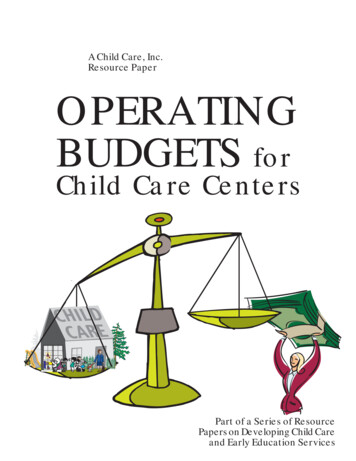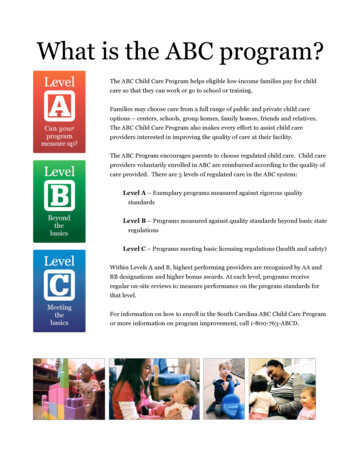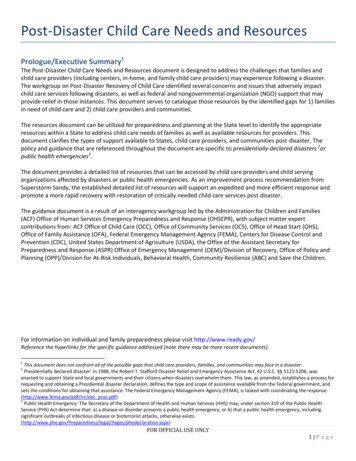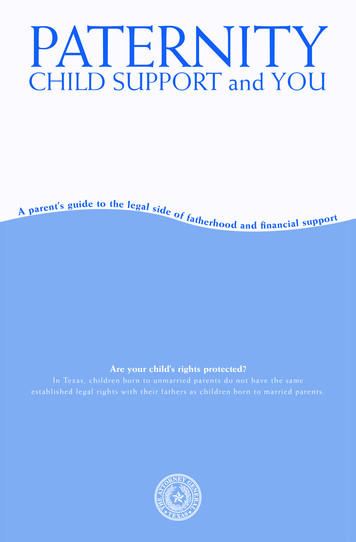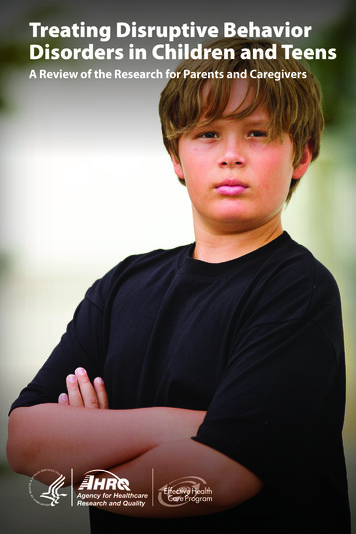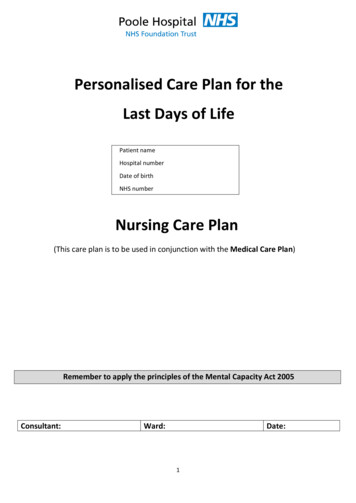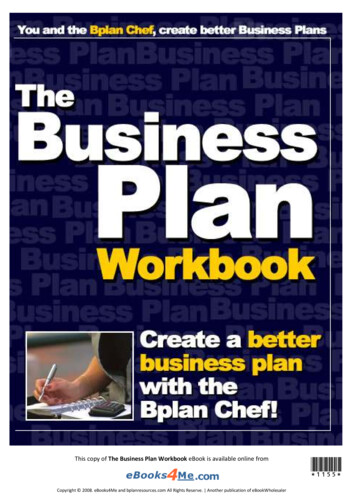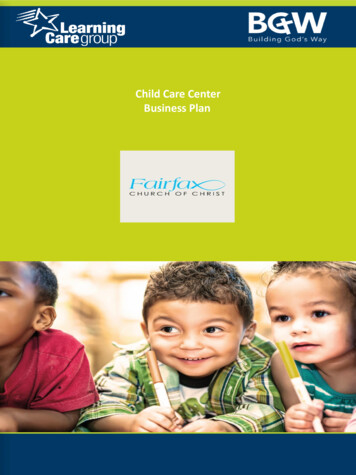
Transcription
Child Care CenterBusiness Plan
Table of ContentsExecutive Summary . .Page 3Study Methodology . .Page 4Recommendation . .Pages 5 – 14 Pro Forma Overview / Programs / Capacity Critical Areas for Considerationo Upfront Costso FFE & Classroom Materialso Playgroundo Pre-Open Costs State Licensing RequirementsWhy Learning Care Group – Our Philosophy.Pages 14 – 38 Our CurriculumCustomized Learning PathwayHealthy Choices, Healthy kidsSafe & SecureElectives / Enhanced LearningAccreditationOperationsLicensing Support & ComplianceTechnologyCentralized SupportAdditional Documentation .Page 382
EXECUTIVE SUMMARYThe Learning Care Group and BGW Sustainable Solutions are pleased to provide this Child Care CenterBusiness Plan for Fairfax Church of Christ. BGW believes that the full integration of financiallysustainable models will allow ministries to become a true catalyst for ministry growth and Kingdomimpact. A significant way to reach the next generation of millennials and their children is through EarlyLearning Centers and a partnership with Learning Care Group. These centers may truly allow ministriesthroughout the United States to shore up financial resources while impacting the Kingdom for “such atime as this.” Esther 4:14For over 25 years, Learning Care Group has partnered with Fortune 500 companies, hospitals,universities and government agencies to design unique early education and child care programs of thehighest quality.We measure success on several different levels: thriving children, happy parents, and satisfiedpartners. Learning Care Group pays particular attention to maintaining ongoing dialogue with ourpartners so that we can continually assess the program’s performance and ensure success. We seekand value feedback from our partners, leveraging these insights to ensure we provide an exceptionalexperience for children, parents, and our partners alike.Learning Care Group emphasizes quality-based education programs, well-maintained and welcomingfacilities, and highly trained teachers and school staff. We employ more than 15,000 dedicateddirectors and teachers who educate and care for our children in state-of-the-art facilities, featuring thelatest technological advances.As one of the nation’s largest child care companies, Learning Care Group has dedicated nearly 50 yearsto providing high quality early education and care for young children. Our company is rooted in thebelief that early childhood education yields profound and long-lasting results – not just in academicachievement, but in virtually every aspect of a person’s life. This belief is central to Learning CareGroup’s mission: To be the premier early child-hood education company in the world & prepareevery child for school and the future.Learning Care Group has the experience and resources necessary to operate the school at FairfaxChurch to the high standards that you expect. We are proud of our long standing client relationshipswhere our schools operate at high levels of safety, quality, and educational excellence which havebeen embraced by our clients’ employees and enrolled families as an extension of their culture.We look forward to the opportunity to collaborate with the leadership at Fairfax Church of Christ onthis exciting endeavor.3
STUDY METHODOLOGYMany factors need to be carefully assessed to determine the feasibility for development of achild care center or expansion of an existing one. A number of key factors include: The demographic and socio-economic composition and number of children ofmarket area resident and worker familiesThe geographic market area that the center will serve. Factors that influence itssize include drive times, patterns of travel to work, competition, psychologicalbarriers, employment growthThe quality and density of competitionMarket tuition rates for child care in the areaAvailable state subsidy assistance for familiesMarket demand for child care by age and socio-economicsThe quality of care to be offeredOperational costsThe objective of the study is to provide a comprehensive picture of the current and forecasteddemand for child care services, the market for child care in the area, potential child care servicetypes, child care center features and estimated costs, and center operating model options.Information was collected through multiple methods including: Advanced Demographic insight on the population of the key market areaEmphasis on determining what the child population consists of within a 10 minutedrive time of the key market area: child population density by age groupSite visits and detailed assessment from our experienced leadership tem with newbuild, competitive analysis and real estate perspectives – which includes initialspace planning discussions, playground assessment, site accessibility, drive patternsMarket based price analysis utilizing our dedicated pricing team and leveraging theirextensive knowledge of the local marketIn-depth licensing requirements review based on state, county and/or municipalityregulatory requirements: teach-to-child ratios, maximum classroom group size,ADA, crib spacing requirements, square footage per child regulations, etc.5 year plan inclusive of forecasted utilization, revenue projections, cash flowprojections; based on localized market pricing, operating best practices, requiredupfront capital, maximizing space utilization, comparing these projected plans toour 900 schools and those in like-marketsRigorous and detailed Competitive Landscape Analysis.4
Learning Care Group did an extensive market study to evaluate the potential opportunity for a childcarecenter at Fairfax Christian Church.Based on the results of our study, Learning Care Group recommends that for Fairfax Church of Christyou should plan to build-out space for a child care center that would allow for a total capacity of 133children of Full-Time-Equivalent.Learning Care Group projects at maturity that this child care center has the potential to generaterevenue and net-profit to the church based on utilization percentages as shown below. The projectedexpenditures and calculated profit share below are included on the attached detailed 5-year pro formado not factor in the upfront costs of opening a new child care center (Cap Ex, Furniture Fixtures &Equipment). Details regarding these costs are covered under Up Front Costs & Pre-Open Costs on Pages7-12. All calculated profit is based off of assumptions that Learning Care Group’s full operating modeland requirements will be implemented. Any change or alteration to program mix, operatingrequirements, or any assumptions detailed in this document or associated exhibits will require an updateto the below table; as well as, the detailed 5-year pro forma.Year 1Year 2Year 3Year 4Year 5Capacity133133133133133Utilization %47%53%62%66%72%6271828896 1,274,506 1,492,385 1,759,529 1,926,864 2,114,068 218,217 305,847 398,325 468,200 554,974EnrollmentRevenueChurch - NetProfit Share* Capacity was determined based on classroom square footage meeting the State of Virginia’s licensing requirements formaximum room capacity and teach-to-student ratios for each age group.** The above is based on a full calendar 12 months operating P&L. not fiscal year. “Year 1” will adjust if not open a full 12 months in thefirst fiscal year.5
Recommended Programs By Room / Capacity:Learning Care Group developed a recommendation for the number of children by age group, therecommended number of rooms required per age group in order to not exceed group maximums perroom according to state licensing. We also factor in the ability to operate in the most cost-efficientmanner from a Teacher-to-Child ratio perspective.Recommended tuition rates based on the market, consumer demographics and competitive landscapeare included in the attached pro 11:81616Early Jr. K11:153015School Age11:183615TOTALS7133Note: Jr. K and School Age are a shared room used at alternate times due to program hours.6
Critical Areas For Consideration - Up Front Costs:The projected annual school expenditures and calculated net-profit included onthe 5-year pro forma do not factor in the upfront costs of opening a new childcare center.Due to typical licensing timelines, the Certificate of Occupancy (C of O) or clearance from buildingofficials in the specific municipality of the center are required prior to applying for the child carelicense. In order to facilitate this process, BGW (or your contracted construction project managerand/or architect) will need to meet with our internal Construction, Licensing, and OperationsManagement to fully define the requirements specific to your space; as well as, determine theappropriate milestones from C of O to the opening of your Center.Ministry shall fund all furniture, fixtures and equipment and other movable items required toprovide the Services at the Center, including, but not limited to, children’s tables and chairs, cubbies,cribs, computers, printers, indoor and outdoor play toys and items, playground equipment, washingmachine, laundry dryer, office desks, chairs, tables, computers, printers, and file cabinets(collectively, “FF&E”).Learning Care Group and Ministry shall work cooperatively to ensure the FF&E complies with theLaw and meets the operational needs of the Center. Ministry shall provide, install and maintain allplayground equipment as well as the appropriate fall zone, all in compliance with the Law.In order to obtain the best pricing possible for all FF&E, Learning Care Group will purchase all of theFF&E on behalf of Ministry. Learning Care Group will invoice Ministry monthly for the cost of thepurchased FF&E in that given month and all months thereafter leading up to the opening date of theschool until all required FF&E have been purchased. Ministry will pay Learning Care Group withinthirty (30) days of Ministry receiving an invoice for any FF&E.See following page for a detailed list of the required FF&E for a school along with projected costsbased on our history of opening new schools across the country. These costs areestimates and may change once the final square footage of the school, finalprograms and final capacity are determined. For more detail on what isincluded in this and what is considered Ministry Responsibility, see theattached Scope Matrix.7
Critical Areas for Consideration – Up Front Costs:Capital BudgetCapital BudgetFurniture / Fixtures / Technology/GraphicsPlayground – Equipment Only*Classroom Furniture &MaterialsTechnology 184,672Equipment – Preschool/ Pre-K 60,000 45,000-50,000Equipment –Toddlers/Twos/Early Preschool 60,000 25,000-29,000Office, Furniture SuppliesGraphics & Signage 63,000-83,000Appliances 40,000-50,000Total CapitalGround Turf, Mulch, Fencing,Concrete** 373–437,000Total EquipmentVaries 250,000 * Playgrounds require specialized installation professionals and installation costs depend on multiplefactors.** Multiple factors play a part in the cost of the playground design elements and would need aconfirmed design and layout in order to have accurate pricing.ITEMIZED LIST OFCLASSROOM FURNITURE & MATERIALS – TECHNOLOGY – GRAPHICS & SIGNAGEClassroom Furniture &Graphics &TechnologyAppliancesMaterialsSignageThis includes all furniture, fixedfixtures and education materials(books, etc.) for each of theclassrooms included in therecommended programs: Infant Room(s) Toddler Room(s) Two’s Room(s) Early Pre-School Room(s) Pre-School Room(s) Junior Kindergarten Room(s) School Age Room(s) Multi-Purpose Room(s) Library Cameras – WatchMe GrowDigital SignageiPads – Teacher &StudentClassroomTechnologyLCW – KiosksLCG NetworkingAppliances & PhonesPrintersStaff PCsAccess Doors /Security GraphicsInteriorBuilding SignMonument Sign Kitchen Appliances –See SpecsWasher/DryerRefrigerator – seespecsFreezer – see specsMini Fridge –Infant/ToddlerRooms8
Critical Areas For Consideration – FFE & Classroom Materials:The classrooms will be used during the week by children enrolled through the Learning CareAcademy. It is understood that classrooms will be utilized by the Ministry on the weekends andpossibly evenings after close of business. Each LCA room will be designed and fitted with ageappropriate furnishings, fixtures, equipment, toys and books. Some toys and furnishings, whilesafe for their respective age group, may not be safe or developmentally appropriate for otherages. It is strongly recommended classrooms be utilized by like-age children during nonbusiness hours. All classrooms will be required to be restored by church resources to their ageappropriate set-up, and cleanliness prior to open for business, after each use.Each classroom will be outfitted with bulletin boards and graphics. This accounts for a greatdeal of available wall space. These bulletin boards are a key component in meetingaccreditation and licensing requirements; as well as providing a platform to reflect thedocumentation of learning, educational images, and parent & staff communication required byour educational philosophy.Any faith-based graphics, quotes, elements required by Fairfax Christian Church in theclassrooms outside of the center’s operating hours should be portable or capable of beingtemporary. Prior to the center’s operating hours, these items should be removed or not bevisible by church resources and should not interfere with the existing LCA boards and/orgraphics.9
Critical Areas For Consideration – Playground:The design for the playground is a direct reflection of our educational philosophy detailed laterin this plan. This was designed in a collaborative effort between our Risk Group, EducationalSpecialists, Operations, Licensing Compliance, Construction, Marketing, and our EquipmentConsultant.The intent of the selected equipment is that it engages the all of the 7 senses: SightHearingSmellTasteTouch Vestibular – Orientation (sense of up or down)Kinesthetic – Balance and body positionThe equipment and turf also allow us to bring the STEAM curriculum outside, while encouragingchild socialization. For example, the multipurpose pods allow for outdoor classroom ordramatic play.Overall, the playground is a main differentiator that directly generates enrollments as it issomething that parents have not seen or experienced at other centers.10
Critical Areas for Consideration – Pre Open Costs: Pre-Open Costs: See following Page for a listing of the anticipated pre open-costs anddetails as to what factors into the anticipated costs. These are estimates and will vary bymarket/location. Pre-Open Costs: LCG has agreed to initially pay all Pre-Open Costs. These costs will thenbe deducted out of the first fiscal year profit at the end of the fiscal year and prior to thecalculation of any Profit Based Fee (Profit Share). If the profit associated with the Center’sfirst fiscal year is insufficient to pay the entirety of the Pre-Open Costs, Learning CareGroup has agreed to deduct the remaining unpaid Pre-Open Costs from the Center’ssecond fiscal year profit at the end of the second fiscal year and prior to the calculation ofany Profit Based Fee (Profit Share). If the profit of the Center’s first and second fiscal years(prior to the calculation of the Profit Based Fee) is insufficient to pay the entirety of thePre-Open Costs, then within (90) days of the end of the Center’s second fiscal year,Ministry shall pay to Learning Care Group the remaining balance of the unpaid Pre-OpenCosts. Fiscal Year Runs: July – June. Actual contract will outline the specifics of invoicing andaccounting for this. Based on both upfront FFE costs pre-open costs, there may be a period of time overthe first several months to up to one year of operation before the church might see anet-profit share. For purposes of this section, “labor expenses” shall mean and include all fees, costs andexpenses related to the hiring, training, employment, wages, salaries and benefitsassociated with any individual Learning Care Group may hire specifically associated withthe Center; examples include the Center Director, Assistant Center Director and teachers.For purposes of this section, “marketing/advertising expenses” shall mean and include allfees, costs and expenses related to any and all efforts at marketing/advertising the Centerprior to its opening for business to the general public.11
Projected Pre-Open Expenses: Roles & Responsibilities - TimelineRole5 Months4 MonthsPrincipal Initial Onboarding &Training Competitive Shopping& CommunityNetworking Begin Enrollmentactivities - Callingprospects Interviewing SEMcandidates Enrollment activities Set-up of the EnrollmentCenter Select & hire the SEM Begin interviewingteacher candidates Interview FRMcandidates Initial Onboarding &Training Assist in Enrollmentactivities Begin interviewingteacher ager3 Months2 Months Enrollment activities Enrollment Select & hire the FRM activities Interviewing teacher Interviewingand other staffteacher and othercandidatesstaff candidates Select & Hire Lead Select & HireteachersLead teachers1 Months Enrollment activities School Setup and Licensingpreparation Facilitate final licensinginspections Assist in onboardingteachers Onsite SupportCentral Training to Lead Teacher training Continued Training prepare for teacherfacilitation & leadership Assist in Enrollment training Assist in Enrollmentactivities Assist inactivities Interview teacherEnrollment Assist in school setup andcandidatesactivitieslicensing preparation Interview teachercandidates Continued Initial Onboarding &TrainingTraining Begin leading Lead Enrollment Activities Assist in EnrollmentEnrollmentactivitiesactivities Teacher Onboarding &Training Assist in School Setup &room preparationLeadTeachers &TeacherFoodSpecialist Kitchen Preparation &initial food ordersBus Driver Begins on openingPre-Open Cost EstimatesCategory5 Months4 Months3 Months2 Months1 MonthTOTALTotal Labor 4,624 5,780 4,624 7,987 47,760.03 70,776TotalControllable 5,162 6,389 5,162 5,162 6,889.50 28,765 2,500Total Facility 2,500TotalMarketingExpense 4,957 6,800 2,434 1,617 9,189.83 25,000PreopeningTotal Cost 14,744 21,470 12,221 14,767 63,839.35 127,04112
Operations & Licensing Requirements:Every state has their own set of requirements as it relates to the operation of a child care orearly education center. This includes, but is not limited to, teacher-to-child ratio, square footageper child, maximum group size, crib spacing, playground square footage minimums, etc.Our proposed programs and capacities were based on factoring in the ideal child care spacebased on market demographics, child-care age child population as well as projected growth inchild population then determining the classroom square footage required to meet the licensingstandards of Teacher-to-Child ratio, square footage per child and group maximums. Theminimum required classroom total square footage for the recommended capacity came outto approximately 4,655 Sq. Ft. The total recommended square footage of the school isestimated at approximately 12,000 square feet which would accommodate for hallways,kitchen, office, registration area and multi-purpose room.StateMinimum Indoor Sq. Ft.Outdoor Sq. Ft.Virginia & LCG Requirements35 Sq. Ft Per Child - All AgeGroups75 Sq. Ft.per child in largest group that willuse the space at any given timeSTATE OF VIRGINIA & LCG OPERATING REQUIREMENTS*Age GroupInfantsToddlers 1Two’s 1EarlyPreschoolPreschoolPre-KJr. KSchool AgeTOTALTeacherchild :1020231:1020221:1020221:1515221:1815221331418* In some cases, LCGOperating Requirementsmay exceed theparticular Staterequirements. We havebased our requirementson 50 years of Experienceand 900 schools13
WHY LEARNING CARE GROUP – Our PhilosophyOur “whole child” educational philosophy includes a focus on essential life skills for the 21stCentury Learner. We know that children need to learn “content knowledge”- things like facts,figures and concepts, but we also know direct instruction with essential life skills is also just asimportant. We discover and support the “executive function” of a child’s brain and itsrelationship to all of these skills: focus and self-regulation, perspective taking, communication,the ability to make connections, critical thinking, taking on challenges and self-directed learning.Learning Care Group intentionally supports these skills to help children manage their attention,emotions, intellect, and behavior to reach their developmental goals on the school readinesspathway.Our classrooms are designed to make education fun, providing students with an optimalenvironment for learning and plenty of opportunities for exploration. The atmosphere is safe,secure and stimulating – helping to foster a perfect place for children to create, explore andthrive. We believe that a safe and secure setting and nurturing relationships with responsiveand respectful adults provides the optimum conditions for learning. These strong, positiveconnections help children establish a capacity for trust, competence, and independence thathelps them grow as students and people. We continue to work hard to ensure that coming toschool enables our children to feel confident, valued and empowered – and that they lookforward to spending each day with us.When you walk into our classrooms, you will find: Collaboration: working with and leading others to solve problemsA nurturing and stimulating environmentCreativity: innovation and personal expressionAge appropriate technology and manipulationA teacher who encourages every child’s curiosityAn opportunity for each child to develop his or her own unique giftsReading time every day14
At Learning Care Group, our schools are staffed by teachers who possess the training; skills andpassion to create engaging and cheerful learning environments that help children reach theirfull potential. Recognizing that staff recruiting and training, as well as retention, play animportant part in the success of each school, we ensure that each of our teachers receives indepth training, meets national accreditation standards, and engages in ongoing professionaldevelopment to continually enhance their skills and knowledge.Data-driven assessmentUsing Learning Care System (LCS), a customized online observation and assessment toolexclusive to LCG, we gauge a child’s developmental growth and assess progress towardslearning critical skills for kindergarten. We developed our proprietary LCS in partnership withAssessment Technology, Inc. (ATI).A leading provider of valid and reliable assessment,curriculum and reporting services, ATI currently serves more than 500 clients nationwide —Including Head Start, K-12 and public early childhood programs, special education earlychildhood programs and private early childhood programs.Using LCS, we evaluate age-appropriate development and progress toward school readiness byassessing growth in 10 key developmental domains: LanguageLiteracyLogic & ReasoningApproaches to LearningCreative Arts Expression Early MathNature & SciencePhysical Development & HealthSocial & Emotional DevelopmentSocial StudiesFor each child, we hone in on 88 critical capabilities within these key areas, linking individualobservation, assessment and lesson planning. This data-driven method enables us to assureparents that appropriate learning goals are being met. As we continue to assess a child’sprogress in developing critical skills, we regularly provide his or her parents with reportsshowing gains made over time.15
Looking at spring vs. fall: 3x as many children mastered skills needed for kindergarten.This past year, we evaluated the growth of 3,073 4-year-olds in 310 Learning Care Group schoolsdemonstrating full implementation of the Learning Care System curriculum. We observedchanges in the children’s individual achievement level between the fall of 2015 and spring of2016, tracking their progress in mastering the critical capabilities from the 10 keydevelopmental domains. Research showed that by spring, we saw three times growth in thenumber of 4 year olds in our program who mastered the skills necessary for kindergarten.Learning Care Group’s strong presence in community-based centers allows us to bring ourexpertise in educational excellence, customer service, marketing, revenue generation, and costcontrol to employer-sponsored care. We are committed to developing successful, lastingrelationships with our clients and our families. We strive to create an atmosphere of mutualrespect, trust and teamwork to ensure that common goals are met. To ensure we deliveroutstanding service, our school management team and staff receive extensive assistance fromregional field leaders and the organizational teams at our “Support Central” headquarters.16
Learning Care Group is rooted in the belief that education should start early in a child’s life andthis belief is central to the company’s mission: to be the leader in child education and familysolutions, which impact and inspire lifelong learning. Our vision is to put into action theobjectives, activities and program components that support each child’s individual growth andlearning.As a leader in the field of early education and child care, we believe that the three mostimportant goals of quality child care, development and education are: Provide a secure, caring and enriched environment for each child by fostering awelcoming environment which will inspire lifelong learning.Focus on each child’s individual education. Through the use of our proprietary LearningCare System, we are able to focus on each child and guide them at the pace at which theyeach individually develop.Promote lifelong learning in each child we care for by helping parents and children feelcomfortable as we build a learning foundation for their future.Learning Care Group puts children first, respecting each child as a valued and unique individualwith distinct interests and opinions. We are sensitive to children’s varying abilities and learningstyles. Through our education programs, children are given the foundations for learning. Theyhave opportunities for choice, experimentation, creativity and problem solving. We understandthe important role families and teachers have in promoting and extending learning. That is whywe create an environment that allows children to grow and develop at their own pace.17
WHY LEARNING CARE GROUP – Customized Learning Pathway18
Every teacher in every classroom along the pathway uses the same set of developmentmilestones to observe and assess each child’s learning and growth throughout their day.Through our unique CYCLE OF INTENTIONAL PLANNING, teachers use these assessments aswell as their knowledge of children’s interests and our digital lesson planning tool to customizetheir weekly lessons plans. Learning goals are personalized for every child!19
20
21
22
23
24
25
26
27
ACCREDITATION - Learning Care Group’s high-quality differentiation is codified throughaccreditation with major national accrediting bodies, including the National Association for theEducation of Young Children (NAEYC), the National Early Childhood Program Accreditation(NECPA), and the National Accreditation Commission (NAC); and state Quality Rating andImprovement Systems (QRIS).All these entities have standards more complex than licensing and focus on: Staff professional development, qualifications, and experienceFamily and community engagementAdministration and managementLearning environmentCurriculum and instructionWe will work toward attaining Accreditation and QRIS participation for this school with thesupport of almost every entity in our company. At the school, our teachers understand theAccreditation and QRIS measurements they must meet in relation to their credentials,professional development, learning environment and curriculum instruction. Our Directors alsounderstand these standards and support the teachers administratively by ensuring they havethe materials they need and ability to attend credential-attaining professional development.70% of Learning Care Group schools have earned national accreditation & quality validation. NAEYC (National Association for the Education of Young Children) NECPA(National Early Childhood Accreditation Program) AdvancED (A global leader in accreditation for Pre-K–12 schools) QRIS(Quality Rating & Improvement System – state-based)28
WHY LEARNING CARE GROUP –OperationsLearning Care Group will be responsible for all aspects of the operation of the care center.These will include: Assume all day-to-day operations of the center including hiring, training and supervision ofstaffCollect tuition and process paymentsEnsure the center meets local and state licensing requirementsImplement our proprietary curriculum and proven policies and proceduresMarketing the center to the local-market community using digital media, search engineoptimization, social media, online directories (care.com, yelp, montrusted.com, etc.)Operational Support: The school(s) would be supported within one of our geographicoperational Divisions, under the leadership of a Divisional Vice President.The school would be under the direct oversight of a District Manager within that Division.Our District Managers typically oversee 8-10 other Learning Care Group schools located withintheir geographic district.District Manager: Will support the school through regular school visits, conference calls and meetingsbetween Lear
The quality of care to be offered Operational costs The objective of the study is to provide a comprehensive picture of the current and forecasted demand for child care services, the market for child care in the area, potential child care service types, child care center features


